
Downtown New Haven is the neighborhood located in the heart of the city of New Haven, Connecticut. It is made up of the original nine squares laid out in 1638 to form New Haven, including the New Haven Green, and the immediate surrounding central business district, as well as a significant portion of the Yale University campus. The area includes many restaurants, cafes, theaters and stores. Downtown is bordered by Wooster Square to the east, Long Wharf to the southeast, the Hill neighborhood to the south, the Dwight neighborhood to the west, the Dixwell neighborhood to the northwest, the Prospect Hill area to the north, and East Rock to the northeast.
The Shubert Theatre is a 1,600-seat theatre located at 247 College Street in New Haven, Connecticut. Originally opened in 1914 by The Shubert Organization, it was designed by Albert Swazey, a New York architect and built by the H.E. Murdock Construction Company. It is currently operated as a non-profit organization by CAPA under the aegis of the Columbus Association for the Performing Arts.

ACES Educational Center for the Arts (ECA), is an American public arts magnet high school, located at 55 Audubon Street in New Haven, Connecticut, United States.
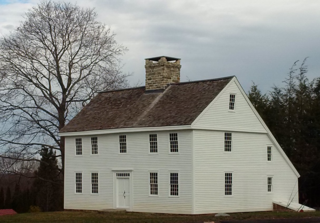
The Nehemiah Royce House, also known as the Washington Elm House, is a historic home located at 538 North Main Street in Wallingford, Connecticut. The saltbox house was constructed in 1672. George Washington visited the house twice, first in 1775 while on his way to take command of the Continental Army in Cambridge, Massachusetts, and again in 1789 when he gave an address to the townspeople in front of the house near the Elm.

The Maryland Theatre is a music and entertainment venue located in the Arts and Entertainment District of downtown Hagerstown, Maryland. It was built in 1915, partially destroyed by fire in 1974, reopened in 1978, and expanded into a full performing arts complex in 2019. The theatre's seating capacity is 1,279 people, and it hosts performances of symphony orchestras, country artists, comedians, children's shows, pop stars, recitals, stage shows, and others. Over 81,000 patrons attended performances at the Maryland Theatre in 2005, making it one of Maryland's premier venues for the performing arts. The Maryland Symphony Orchestra performs there regularly and has been headquartered in the building since 2019. The theater features a fully restored Wurlitzer theatre organ.

Lincoln Park is a city square and neighborhood, also known as "the Coast," in Newark, Essex County, New Jersey, United States. It is bounded by the Springfield/Belmont, South Broad Valley, South Ironbound and Downtown neighborhoods. It is bounded by Martin Luther King Jr. Blvd. to the west, West Kinney St. to the north, the McCarter Highway to the east and South St., Pennsylvania Avenue, Lincoln Park and Clinton Avenue to the south. Part of the neighborhood is a historic district listed on the New Jersey Register of Historic Places and the National Register of Historic Places. Lincoln Park as a street turns into Clinton Avenue toward the south and north edge of the park.
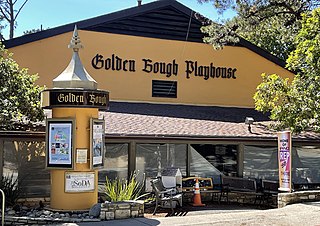
The Golden Bough Playhouse is a historic two-story theatre in Carmel-by-the-Sea, California on Monte Verde St., between 8th and 9th Avenues. The playhouse occupies the site of the former Carmel Arts and Crafts Club, Carmel's first cultural center and theatre, built in 1906–1907 on Casanova Street, and the Arts and Crafts Hall, built in 1923–1924 on an adjacent lot on Monte Verde Street. Since 1994, the facility has been owned and operated by Pacific Repertory Theatre, Monterey County's only year-round professional theatre company. A two-phase renovation of the aging facility began with an interior building project in 2011. A second phase project, including both interior and exterior renovations, is scheduled for 2021. The theatre was recorded with the National Register of Historic Places on July 3, 2002. It is significant as a California historic building because it is located on the original site of the Carmel Arts and Crafts Club and theatre, the oldest performing arts venues in Carmel.

The Missouri Theatre, is a concert and entertainment venue in downtown Columbia, Missouri, occupying most of a city block between 9th street between Locust and Elm Streets. It was designed after the Opéra Garnier by the Boller Brothers, built in 1928, and is on the National Register of Historic Places. It is Columbia's only surviving pre-Depression movie palace and vaudeville stage. In 2011, the University of Missouri began a three-year lease of the facility. The Missouri Theatre is the resident home of the Missouri Symphony Orchestra, and is also frequently used by University of Missouri and civic groups. As of July 1, 2014, The University of Missouri took over ownership of the Missouri Theatre. It is one of the main performance venues for the University of Missouri School of Music.

The Madam C. J. Walker Building, which houses the Madam Walker Legacy Center, was built in 1927 in the city of Indianapolis, in the U.S. state of Indiana, and as Madam C. J. Walker Manufacturing Company, it was designated a National Historic Landmark in 1991. The four-story, multi-purpose Walker Building was named in honor of Madam C. J. Walker, the African American hair care and beauty products entrepreneur who founded the Madam C. J. Walker Manufacturing Company, and designed by the Indianapolis architectural firm of Rubush & Hunter. The building served as the world headquarters for Walker's company, as well as entertainment, business, and commercial hub along Indiana Avenue for the city's African American community from the 1920s to the 1950s. The historic gathering place and venue for community events and arts and cultural programs were saved from demolition in the 1970s. The restored building, which includes African, Egyptian, and Moorish designs, is one of the few remaining African-Art Deco buildings in the United States. The Walker Building was added to the National Register of Historic Places in 1980.
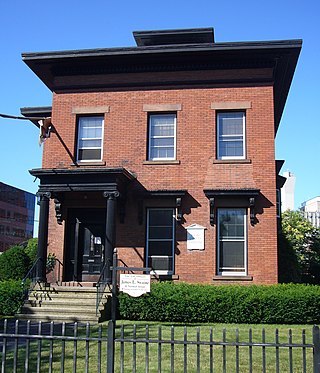
The Lafayette B. Mendel House is an historic Italianate house at 18 Trumbull Street in New Haven, Connecticut. This building, designed by New Haven architect Henry Austin, was the home of Yale University physiology professor, Lafayette Benedict Mendel (1872–1935) from 1900 to 1924. It was declared a National Historic Landmark in 1976 for its association with Mendel, who discovered vitamins A and B, and greatly expanded knowledge of nutrition and food-related biochemistry. The building now houses a law firm.

The Grand Opera House, also known as The Grand or Masonic Hall and Grand Theater, is a 1,208-seat theater for the performing arts in Wilmington, Delaware, United States. The four-story building was built in 1871 by the Delaware Grand Lodge of Masons to serve as a Masonic Temple and auditorium. The construction cost was $100,000. It was designed in Second Empire style by Baltimore architect Thomas Dixon and incorporates symbolism from Freemasonry into the cast-iron facade. Its central pediment contains an Eye of Providence.

The Katharine Hepburn Cultural Arts Center, known as The Kate, is a performing arts center in Old Saybrook, Connecticut that opened in 2009. It is named for Katharine Hepburn, the 4-time Academy Award winning actress and Old Saybrook's most celebrated resident.

Plymouth Congregational Church, also known as Plymouth Church or Temple Keser Israel, is a former late-nineteenth-century Congregational Church at 1469 Chapel Street in New Haven, Connecticut. The church, a fine example of Romanesque Revival architecture, was listed on the National Register of Historic Places in 1983. The church is a notable example of an adaptive reuse, having been converted into a synagogue and medical office building.
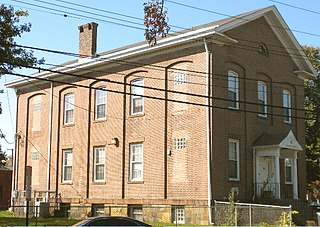
The Goffe Street Special School for Colored Children is an important landmark of African-American history at 106 Goffe Street in New Haven, Connecticut. The building, also known as Prince Hall Grand Lodge of Masons, was added to the National Register of Historic Places in 1979.

The Caroline Nicoll House is a historic house at 27 Elm Street in New Haven, Connecticut, USA. Built in 1828, it is a rare surviving example of an urban townhouse from that period, and a well-preserved example of transitional Federal-Greek Revival architecture. The house was listed on the National Register of Historic Places in 1983.
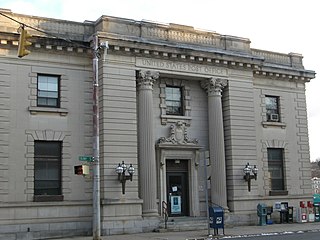
The former U.S. Post Office-Meriden Main, also known as Meriden Main Post Office, is located at 89 Colony Street in Meriden, Connecticut. Built in 1907 and extended in 1932, it is a striking local example of Beaux Arts architecture. The building was listed on the National Register of Historic Places in 1986. It no longer houses the city's main post office, which is at 190 Center Street.

The Hollywood Theater is a historic theater building in Minneapolis which is listed on the U.S. National Register of Historic Places. The Art Deco theater building opened on October 26, 1935, and the marquee proclaimed it the "Incomparable Showcase of the Northwest". The theater, designed by architects Jack Liebenberg and Seeman Kaplan, had a generous budget that allowed for elaborate decoration in the Streamline Deco style of design; its facade and structure made a "powerful statement of geometric mass punctuated by the entrance, exits, and three small windows that served the projection booth." Liebenberg and Kaplan went on to design the Riverview Theatre in Minneapolis and the Terrace Theatre in Robbinsdale. The building featured a tall vertical sign, a patterned terrazzo floor, gilded pillars, and acoustical tiles in geometric patterns. It had a seating capacity of just under 1000. Much of the interior features are influenced by the Zig-Zag Moderne and Streamline Moderne styles. The exterior is built of smooth Kasota limestone with vertical lines that transition to horizontal.
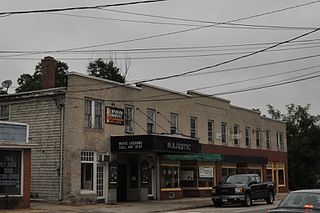
The Bolduc Block, also known as the Majestic Theater, is a historic commercial and theatrical building at 36 Main Street in Conway, New Hampshire. Built in 1923, it was the community's first theater. It is also a good local example of Art Deco architecture, a style uncommon in northern New Hampshire, fire damage to its interior. The building was listed on the National Register of Historic Places in 2016, and the New Hampshire State Register of Historic Places in 2015. It is presently owned by the Mountain Top Music Center.
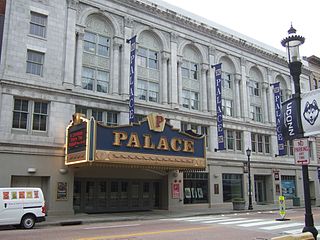
The Palace Theater is a 2,900-seat auditorium at 100 East Main Street in downtown Waterbury, Connecticut. The theater currently presents a variety of live entertainment, hosting traveling productions and locally produced events. It was built in 1921 to a Renaissance Revival design by Thomas W. Lamb, and is an architecturally prominent element of the city's downtown. It underwent a major restoration in the early 21st century, and is listed on the National Register of Historic Places.

The Palace and the Majestic are a pair of historic performance and film venues at 1315-1357 Main Street in downtown Bridgeport, Connecticut. Built in 1921-22 by Sylvester Z. Poli in a single building that also housed a hotel, they were in their heyday a posh and opulent sight, designed by noted theater architect Thomas W. Lamb. The building has stood vacant and decaying since the 1970s, despite repeated attempts to restore its grandeur. The building was listed on the National Register of Historic Places in 1979.





















